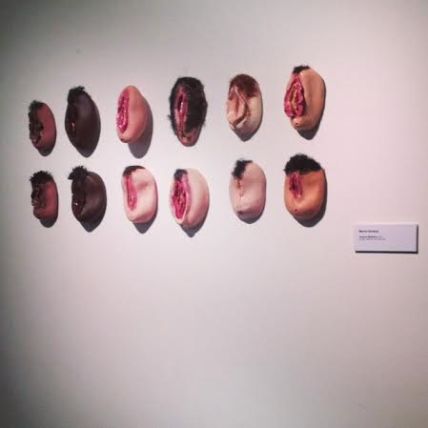 Marina Santana, Designer Mutilation, 2013
Marina Santana, Designer Mutilation, 2013
Acrylics, Ceramics, and Human Hair
The Intimate Details of Vaginal Variations
Recent Cal State San Bernardino graduate Marina Santana cleverly brings to light society’s misogynistic categorization and blatant objectification of the female anatomy with Designer Mutilation, 2013, one of the artist’s two installations on view at the university’s Dutton Family Gallery as part of the Winter Quarter 2014 exhibition “Intimate Details”. Seamlessly fixed, as if afloat on the expanse of stark white walls, Designer Mutilation is comprised of a small variety of delicately painted ceramic forms resembling close-up views of female genitalia. Each is roughly 5 inches in length and candidly reflects the vulva of one of twelve women,including the artist. The subjects, which Santana sourced through Frannie Adam’s Pussy Portraits, 2009, a 96 page photo book featuring full page juxtapositions of each women’s portrait and vagina, range from their mid-20s and up in age and are all exhibited anonymously alongside Santana’s more openly disclosed self-portrait.
The twelve modestly sized eye-level protrusions stand before the viewer utterly exposed, eliciting an in-your-face veracity comparable to that of Finnish sculptor Mimosa Pale’s 8-foot tall Mobile Female Monument, 2007, or even the infamous vaginal chewing gum body lesions of Hannah Wilkie from the 1970s. Santana’s bold utilization of the vulva presents an air of comfort and vague familiarity that remains in dialogue with other contemporary works of iconic feminist conceptual art. With each delicately crafted mound, riddled with dissimilarities, protruding out towards the viewer, the piece literally beckons the eye to draw closer for thorough inspection.
Ultimately, Designer Mutilation seems to construct its provocation within a neatly presented, multifaceted experience; it illuminates, it examines, and it provokes. Calling to mind the many works of art crafted throughout history created solely to depict the female anatomy according to a more desirable male fantasy,Designer Mutilation reconsiders the female anatomy from the context of a patriarchal society, consequently eulogizing the form without idealizing it by illustrating in intimate detail the individual nature of each woman’s body.
Mounted, spread out, bare, and limbless, Designer Mutilation invites the viewer’s eyes to careen inside of the sparingly or generously haired gentle painted folds, each existing as a metaphorical portal of ascent for the woman who may find herself struggling with insecurities about the aesthetic structure of her own genitalia, insecurities that society has defaulted to as a cruel result of the senseless barrage of explicit and implicit mass media propaganda. According to The International Society of Aesthetic Plastic Surgeons, this phenomenon has prompted nearly 5,200 women annually to consider cosmetic surgery in their pursuit for vaginal transcendence, or, the genital norm. Santana’s piece responds to this call by obliterating the preconceived notion of a singularly “ideal” female aesthetic.
-April Baca



